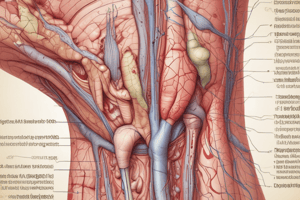Podcast
Questions and Answers
Which of the following functions of the integumentary system is responsible for regulating the balance of fluids and electrolytes?
Which of the following functions of the integumentary system is responsible for regulating the balance of fluids and electrolytes?
- Sensory perception
- Vitamin D production
- Water and electrolyte balance (correct)
- Thermoregulation
Which layer of the skin is composed of subcutaneous tissue?
Which layer of the skin is composed of subcutaneous tissue?
- Dermis
- Epidermis
- Stratum corneum
- Hypodermis (correct)
What is the primary function of sebaceous glands?
What is the primary function of sebaceous glands?
- Aiding in sensory perception
- Regulating body temperature
- Lubricating and protecting the skin (correct)
- Producing cerumen
Which of the following is NOT a function of the skin?
Which of the following is NOT a function of the skin?
What is the outermost layer of the skin?
What is the outermost layer of the skin?
Which of the following is a function of hair?
Which of the following is a function of hair?
Flashcards are hidden until you start studying
Study Notes
Integumentary System Overview
- The integumentary system is a complex system that protects the body from external damage, regulates body temperature, and aids in the senses of touch and feel.
- It consists of the skin, hair, nails, and associated glands.
Functions of the Integumentary System
- Protection: shields the body from external factors such as mechanical injury, UV radiation, and infection
- Thermoregulation: helps regulate body temperature through sweating and vasodilation/vasoconstriction
- Sensory perception: contains sensory receptors for touch, pressure, pain, and temperature
- Water and electrolyte balance: helps regulate the balance of fluids and electrolytes through sweating
- Aid in vitamin D production: skin exposure to UV radiation triggers vitamin D production
Skin Structure
- Epidermis: outermost layer, composed of stratified squamous epithelium
- Dermis: middle layer, composed of connective tissue
- Hypodermis: innermost layer, composed of subcutaneous tissue
- Skin layers: from outermost to innermost: stratum corneum, stratum lucidum, stratum granulosum, stratum spinosum, stratum basale
Skin Functions
- Barrier function: prevents water loss and entry of foreign substances
- Immune function: contains immune cells such as Langerhans cells and keratinocytes
- Regulation of body temperature: through sweating and vasodilation/vasoconstriction
- Sensory function: contains sensory receptors for touch, pressure, pain, and temperature
Associated Glands
- Sweat glands: produce sweat to regulate body temperature and aid in water and electrolyte balance
- Sebaceous glands: produce sebum to lubricate and protect the skin
- Ceruminous glands: produce cerumen to protect the ear canal
Hair and Nails
- Hair: protects the skin, regulates body temperature, and aids in sensory perception
- Nails: protect the tips of fingers and toes, and aid in sensory perception
Integumentary System Overview
- Protects the body from external damage, regulates body temperature, and aids in the senses of touch and feel
- Comprised of skin, hair, nails, and associated glands
Functions of the Integumentary System
- Shields the body from external factors such as mechanical injury, UV radiation, and infection
- Regulates body temperature through sweating and vasodilation/vasoconstriction
- Contains sensory receptors for touch, pressure, pain, and temperature
- Regulates the balance of fluids and electrolytes through sweating
- Aids in vitamin D production through skin exposure to UV radiation
Skin Structure
- Epidermis: outermost layer, composed of stratified squamous epithelium
- Dermis: middle layer, composed of connective tissue
- Hypodermis: innermost layer, composed of subcutaneous tissue
- Skin layers: from outermost to innermost: stratum corneum, stratum lucidum, stratum granulosum, stratum spinosum, stratum basale
Skin Functions
- Prevents water loss and entry of foreign substances through barrier function
- Contains immune cells such as Langerhans cells and keratinocytes for immune function
- Regulates body temperature through sweating and vasodilation/vasoconstriction
- Contains sensory receptors for touch, pressure, pain, and temperature for sensory function
Associated Glands
- Sweat glands: produce sweat to regulate body temperature and aid in water and electrolyte balance
- Sebaceous glands: produce sebum to lubricate and protect the skin
- Ceruminous glands: produce cerumen to protect the ear canal
Hair and Nails
- Hair: protects the skin, regulates body temperature, and aids in sensory perception
- Nails: protect the tips of fingers and toes, and aid in sensory perception
Studying That Suits You
Use AI to generate personalized quizzes and flashcards to suit your learning preferences.




